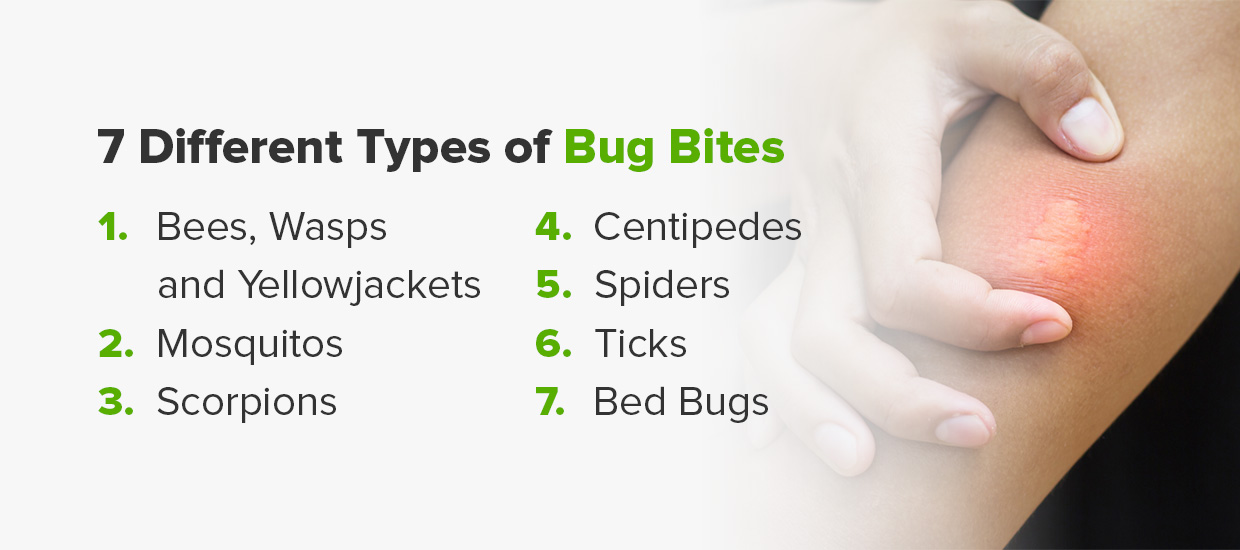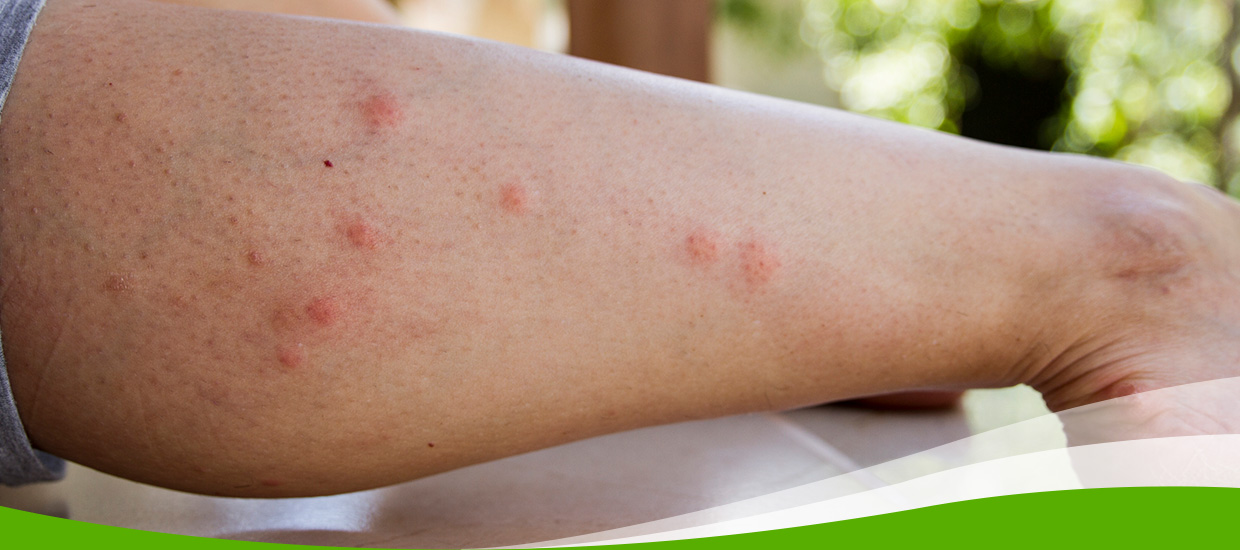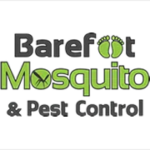If a swollen, painful or itchy mark has appeared on your skin, you’d probably like to know what caused it. Many bug bites look similar, so figuring out what creepy crawly bit you can be challenging. In most cases, a bug bite won’t be harmful, but knowing what bite you have can help you treat it properly and look out for more serious symptoms.
To help you solve the mystery, we’ve compiled some common bug bites you might encounter and tips for figuring it out.
How to Identify a Bug Bite
We’ll go over common bug bites next, but if none seem right, you can often find your answer with a good Google search. Describe the bite and see if the bug that comes up lives in your area.
Many bites will look similar, but characteristics to pay attention to include:
- Size and shape
- Redness
- Pain level
- Itchiness
- Sensation of heat
- Grouping with other bites
- Bruising
How to Treat a Bug Bite
Most bug bites and stings have a similar treatment process:
- Clean the area with soap and water.
- Apply an ice pack or a cold, damp washcloth to reduce swelling.
- Take an over-the-counter antihistamine to reduce itching and swelling.
- Use a calming lotion or cream, such as calamine lotion or hydrocortisone cream, to help with itching and swelling.
Some bugs carry serious diseases, so symptoms like fever, nausea, sweating or muscle pain can signify something more severe. They typically warrant a trip to the doctor’s office. Almost all bugs can cause significant allergic reactions, which could involve excessive swelling or heat. Insects with stingers are also known for potentially causing anaphylactic responses, like trouble breathing, a swollen tongue and hives. These situations require immediate medical attention or an epinephrine auto-injector.

7 Different Types of Bug Bites
Now, let’s dive into the countless bug possibilities! Here’s our handy bug bite identifier list, complete with different types of common bites, stings and marks.
1. Bees, Wasps and Yellowjackets
If you get stung by one of these insects, you’ll know it. They pierce the skin with their stingers and inject venom into the body.
Bees — which are unlikely to sting you — leave a red, inflamed area with a small white circle around the sting. They can be painful, swollen and itchy. You’ll need to remove the stinger before treating the area. Wasps leave similar marks but keep their stingers.
A yellowjacket sting might be a little more painful. They can cause itching, warmth at the sting site and even some fatigue. They won’t leave stingers behind either, but the treatment is similar to a bee sting.
Allergies to bee and wasp stings are common, so be on the lookout for more severe symptoms.
2. Mosquitos
You probably know what a mosquito bite looks like. It’s a common itchy type of bug bite, usually accompanied by a raised, reddish bump. Mosquito bites themselves are more annoying than dangerous — although they can carry diseases like Zika virus and Dengue Fever. Hydrocortisone cream can relieve itching, and ice packs help reduce swelling. Whatever you do, don’t scratch mosquito bites, which can lead to infection.
3. Scorpions
If you live in a warm area, like we do in the southern United States, you might have scorpions hanging around. These arachnids may look dangerous, but their sting is usually similar to a bee sting. They can cause pain and localized swelling. In the United States, only one of about 70 species of scorpion is considered dangerous to humans, and it lives in Arizona and specific parts of California and New Mexico.
4. Centipedes
Yes, centipedes can leave a mark. They don’t actually bite, instead using claw-like forelegs filled with venom. Centipedes don’t typically use these claws on humans, but you might see a trail of marks on your skin from the forelegs scratching against you. They could leave blisters, too. Some people don’t notice centipede bites, but others say they feel like bee stings.
5. Spiders
Before you panic about a possible spider bite, know that out of 40,000 species worldwide, only about a dozen can hurt a healthy adult. In the United States, the primary concerns are black widows and brown recluses, and their bites are still rare.
With that reassurance, most spider bites look a lot like other bug bites, with localized swelling and redness. They may hurt more than other bites, and sometimes you’ll see fang marks, or two small holes, in the middle of the bite. Also, if you have a bug bite that looks like a bruise, a spider could be the culprit.
If you have whole-body symptoms, you might be looking at a bite from one of the dangerous species we mentioned. A bite from a black widow can cause muscle stiffness and pain, nausea or vomiting, sweating, belly pain or cramping, trouble breathing and swollen eyelids. A brown recluse bite causes tissues around the area to die off and turn into an ulcer. Some of the first symptoms include muscle pain, blistering and bruising, but severe symptoms can also occur, such as fever, dizziness and vomiting.
If you experience any of the above symptoms, see a health care provider immediately. While fatal spider bites are rare, you will likely need medical attention.
6. Ticks
Tick bites are easy to miss because they’re relatively painless. You could, however, see a tick attached to you — which is a pretty good giveaway of what you’re working with. Before you can treat the bite, you’ll need to remove the tick, which can be tricky and requires the following steps:
- With a good pair of tweezers, grab the tick as close as possible to the skin’s surface.
- Pull straight up and away with steady pressure, and avoid twisting or bending the tick.
- Check the bite for any parts of the tick that may have been left behind, like a head or mouth. Remove them if necessary.
- Clean the bite with water and antibacterial cleanser, rubbing alcohol, iodine or alcohol-based hand sanitizer.
- After removing the tick, submerge it in rubbing alcohol to kill it. Then, place it in a sealed container. If you show severe symptoms later, your doctor may want to analyze the tick for species and pathogens.
These bug bites look like mosquito bites. While the bites themselves are usually harmless, ticks are known carriers of dangerous diseases like Lyme disease and Rocky Mountain spotted fever. Lyme usually comes with a characteristic bullseye-shaped mark. If you have whole-body symptoms like fever, fatigue, muscle aches, vomiting or abdominal pain, see your doctor immediately.
7. Bed Bugs
Wondering why your bug bite looks like a line of bumps? Bed bug bites are one of the best indicators of these critters. You may not notice them at night, but you will probably see the red line of small bites going up your body. These bites are usually raised and itchy. Another sign you might be dealing with bed bugs is if you see reddish or reddish-brown spots on your bedding. These spots can be from blood or bug droppings.
If you see signs of bed bugs, get rid of them immediately. Bed bugs can be hard to kill and find, and they can quickly cause an infestation. You’ll often need professional services.
Avoiding Bug Bites With Pest Control
You might not be able to avoid some of these bugs in the wild, but they should never take residence in your home, yard or business. If you notice these bites or otherwise suspect bugs in your space, professional pest control services can eliminate them and keep them from returning.
In East Texas, Barefoot Mosquito & Pest Control is your full-service provider, offering a wide range of pest control options. We use minimal pesticides and take a comprehensive approach to identify points of entry, kill existing bugs, discourage insect migration and remove habitats. From bed bugs to wasps and everything in between, we’re here to help residents and business owners in Houston, Austin, San Antonio and the surrounding areas.
Reach out today to talk to a pro and get an estimate!



